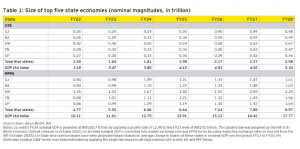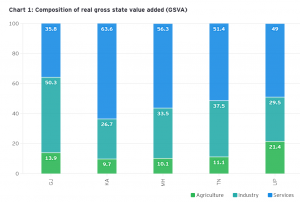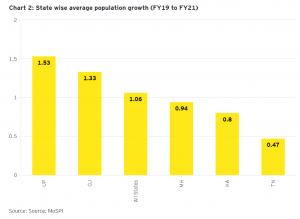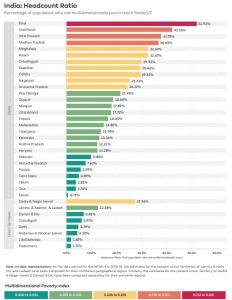
India has an ambitious goal of becoming a $5 trillion economy by the financial year 2027-28. The Union government has lined up a series of steps to make this dream a reality, but achieving this goal would not be possible without active contribution from states. Some states are expected to play a larger role in achieving this target than others. According to a recent report by EY, five states together will be crucial for realising the $5 trillion target. These states — Maharashtra, Tamil Nadu, Uttar Pradesh, Gujarat, and Karnataka – together will have a combined GSDP of $2.6 trillion by FY28.
This means the rest of the states will not have a significant role in realising the $5 trillion economy goal. West Bengal, Rajasthan, Andhra Pradesh, Telangana, Madhya Pradesh, and Kerala are the next set of states that will contribute most towards the $5 trillion dream.
READ | RBI must focus on growth amid global turmoil
5 States to power $5 trillion economy dream
Each of this five states will have a different mix of growth drivers among agriculture, industry and services. For instance, the Yogi Adityanath government in Uttar Pradesh has a large agricultural sector and is also home to a growing manufacturing industry. Considering the average sectoral shares for the pre-Covid period of FY18 to FY20, it is seen that the share of agriculture in GVA has been the highest for UP at 21.4%. Uttar Pradesh also has the highest population in India. In general, states with a high population growth are likely to have a larger working-age population which will, in turn, have a bearing on the way the demographic dividend unfolds in these states.
Size of top five state economies

According to the EY report, states with a relatively larger share of agriculture are expected to experience lower growth as the average growth in agriculture has been relatively lower than that of industry and services. Between industry and services, the services segment is expected to report higher growth. The average all-state growth in industry during FY13 to FY20 was comparatively lower at 6.1% compared with 7.5% for services.
Composition of real gross state value added (GSVA)

Maharashtra is the largest state in terms of GSDP. The state has been a key contributor to India’s growth in the past too. The state is home to Mumbai, the financial capital of India, and has a strong manufacturing and services sector. Home of Prime Minister Narendra Modi, Gujarat, has been a leading contributor to India’s growth in recent years. The state has a strong presence in the chemical, pharmaceutical, and textile industries and is also the base of the largest petrochemical complex in India. Gujarat is also an export-oriented economy, contributing to India’s growth through a growth in net exports.
State-wise average population growth (FY19- FY21)

Two southern states that feature in the list — Tamil Nadu and Karnataka. Tamil Nadu is one of the most commercially successful states in the country and has a strong presence in the automobile, electronics, and textile industries. The state’s capital Chennai is also a major IT hub. Karnataka, on the other hand, is home to India’s technology hub Bengaluru, and has a strong presence in the software and services industries. The state also has a growing manufacturing industry, with a focus on aerospace and defence. However, the agriculture sector is not a strong point of this southern state.
India’s rich and poor states

According to a recent report by the Reserve Bank of India (RBI), the financial health of Indian states is on the mend after two years of the crippling pandemic. However, debt consolidation at the state level warrants urgent attention and a glide path needs to be set to create the fiscal space to deal with future shocks. The Gross fiscal deficit (GFD) of states is budgeted to narrow to 3.4% of gross domestic product (GDP) in 2022-23 from 4.1% in 2020-21. This was helped by broad-based economic recovery and higher revenue collections, as per a Reserve Bank of India (RBI) report released in January.
The road ahead
The contribution of each state towards India’s $5 trillion economy goal will depend on various factors including the policies adopted by the state governments, the states’ resource endowment, and the overall economic environment in the country. First and foremost, each state must look at attracting investments and create an enabling environment that attracts both domestic and foreign investment. This can be done by providing a favourable policy environment, streamlining of procedures and approvals, and ensuring ease of doing business.
These states must not ignore providing support to their entrepreneurs. Supporting start-ups can create more jobs and generate economic growth. However, to provide a fillip to India’s buzzing start-up market, respective governments must look at offering incentives like tax breaks, subsidies, and low-interest loans. Another sector which can play a significant part in boosting state GDPs is tourism. The industry can generate significant economic activity and create employment opportunities. However, this will require heavy investments in infrastructure, promotions of tourist destinations, and simplifying procedures for obtaining tourist visas.
The North-South divide
India will overtake China as the most populous country this year. Its population is growing at a steady pace, while China’s growth rate has fallen below what is known as the replacement rate, or 2.1 children per woman. The UN had estimated last year that India’s population was 1.39, while China’s was 1.41 billion.
India’s population growth will present a complex situation for the government which will face the twin trouble of baby boom and ageing in different states. The demographic trends in the northern and southern states offer a study in contrast. Population in the country’s rich southern states has stabilised and is showing signs of decline. In the poorer northern states, the population is still rising.
The global population has touched 8 billion last year. India is among the eight countries that will contribute half of the projected rise in population till 2050. The population growth in the poorer states will put tremendous pressure on the Indian economy and government finances.
